 Source
of Confusion: A graphic attempt to explain useful sources versus less useful
ones, for garments
Source
of Confusion: A graphic attempt to explain useful sources versus less useful
ones, for garments Source
of Confusion: A graphic attempt to explain useful sources versus less useful
ones, for garments
Source
of Confusion: A graphic attempt to explain useful sources versus less useful
ones, for garments
There is confusion in the SCA (and, presumably, other historical
organizations) regarding primary sources, secondary, tertiary, and so on,
and not enough discussion about what constitutes a good source versus
a bad source -- an axis of analysis which is very valuable to evaluating
an item that has been recreated. Some of these confusions are propagated
by contest judges. I hope to make the issue very clear: that it is
far more useful to worry about quality of source, rather than its position
on the primary/secondary chart.
Segments on this page:
The first issue in this puzzle is: What is the original item?
We can't have things or concepts that come from the original item without
knowing what the original is.
If you are documenting painting technique -- a painting is an original.
If you are documenting costume -- a piece of period clothing is an
original.
If you are documenting royal edicts -- a manuscript is an original.
If you are documenting something that is not an artifact, such as a
musical performance or a battle -- the concept gets murky. It may
be that the original, by its nature, is forever lost.
Knowing what is the original, is thus, for items, relatively easy. The trouble comes starts with the term "primary" because it is weighted with a sense that primary is automatically better, desireable, the pinnacle of sources available. This emotional content gets in the way of clear thought. An original item is a primary source, but it may not be the best source.
The use of primary/secondary/tertiary in archeological sources is rarely
defined in the texts we historical costuming people use (such as the Museum
of London series) ; it's something those in that field understand, and
if you have a book entirely about primary sources, why define elementary
terms? Here is a link to a description
of primary sources about a historical event -- but an event's primary
source, such as a letter, is not a primary source for a garment; the garment
itself is the primary source. Failing a textbook at my elbow, the
definition in the online Merriam-Webster Dictionary
will have to do:
primary: 3a: DIRECT, FIRSTHAND <primary sources of information> b: not derivable from other colors, odors or tastes [...] e: belonging to the first group or order in successive divisions, combinations or ramifications <primary nerves>The relevant parts of the above definition are "not derivable" and "first group in successive divisions." Using the example given of nerves, note that a secondary nerve is still a secondary nerve, even if the primary nerve is not present. Likewise, a primary source of information is the one that all other derivative sources proceed from. So it is with garments; an original garment itself is the primary source for any derivative works. The derivative works, such as a photo, a painting, or a re-creation of the garment, are secondary sources. They have the potential to be darn good secondary sources, but in the process of making them, information is lost, new information is added, or human interpretation may interfere with presentation.
For illustration, let us consider the situation from a less theoretical perspective. I have, on my scanner, a common cotton sock. The following picture of the sock is of course one generation removed from the real sock, but since the Internet won't yet let me conjure actual socks for you to paste onto your computer monitor, we'll have to pretend that the picture is a real sock, and proceed from there.
It is useful to think of the progression of sources rather like a genealogical
tree; the sock begets secondary copies of itself, and those in turn beget
secondary copies of themselves, i.e., tertiary copies of the original sock.
The
chart below may be too wide to show in your browser window; slide your
width slider button around so you know what is there.
Primary source |
 |
- |
||||
Secondary sources |
-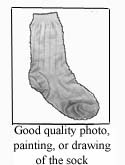 |
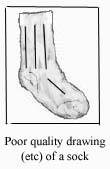 |
-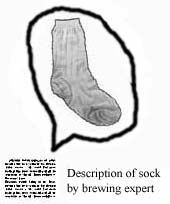 |
-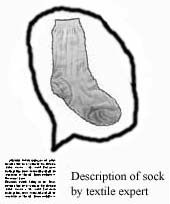 |
||
Tertiary sources |
-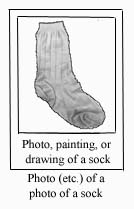 |
-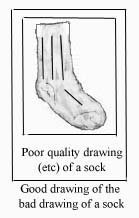 - - |
-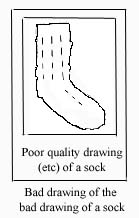 - - |
|||
There is a critical thing to notice in this table. Some of the secondary sources are going to be less useful than other secondaray sources -- the bad (inept) drawing of a sock is less useful than the good (clear, high resolution, etc.) photo of a sock.
In addition, some information will be lost in each subsequent copy of the sock, even if great care is taken to replicate it as accurately as possible. Consider a photocopy that is then photocopied through several generations. Eventually it's a real mess, even though a photocopier reproduces in near photographic quality. Consider also the party game "Whisper down the lane" or "Telephone." By the end of the information transmission game, all of the content of the orginal message has been substituted for erroneous information.
Once dubious quality is put in the equation, subsequent generations will be unlikely to regain quality, so even an excellent copy of a bad drawing will itself be a bad source. Of course, a bad copy of a bad drawing of the original sock can get worse yet!
The colors in the chart above, then, are a rough cue for research usefulness of the source.
The primary source itself, is generally unimpeachable. But what about a terrible example of a sock, perhaps one knit by myself? It would not be representative of the usual 20th Century sock. A sock knit by me, although a primary source, is a poor source. Likewise, just the cuff of even a good sock would not be enough information to reconstruct a real sock. Thus a partial primary source is likewise suspect.
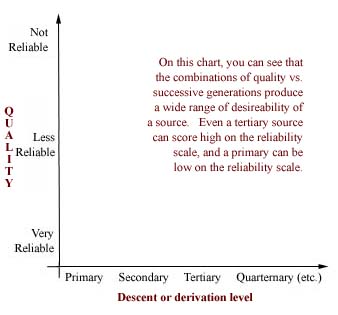 Taking
all these factors into consideration, you can see that the worthiness of
a source is a combination of its rank on the primary/secondary/tertiary
hierarchy, PLUS its quality/reliability hierarchy. Either scale by
itself is not a reliable metric in evaluating worthiness of a source, and
using only one of them (most especially, using only the primary/secondary
hierarchy) can be downright misleading. Both metrics must be
used, and ruling out a source solely on the basis of primary/secondary/tertiary
is only half the picture. Or half the sock.
Taking
all these factors into consideration, you can see that the worthiness of
a source is a combination of its rank on the primary/secondary/tertiary
hierarchy, PLUS its quality/reliability hierarchy. Either scale by
itself is not a reliable metric in evaluating worthiness of a source, and
using only one of them (most especially, using only the primary/secondary
hierarchy) can be downright misleading. Both metrics must be
used, and ruling out a source solely on the basis of primary/secondary/tertiary
is only half the picture. Or half the sock.
 A
footnote to all this: Do not fail to evaluate synthesized works (such as
my own or other people's webpages, teaching handouts, published general
books on "costume" etc.) by these criteria. How good do the sources
cited in the handout appear? Are there any medieval (or Ren.) works
cited or reproduced at all? How well are they reproduced? (I've
seen some that ask you to take everything on faith in the teacher or his
drawings!) What is the quality of the teacher's own sources?
Do you think the teacher has made good conclusions? Such careful
analysis can stop the propagation of poor information and replace it with
better information.
A
footnote to all this: Do not fail to evaluate synthesized works (such as
my own or other people's webpages, teaching handouts, published general
books on "costume" etc.) by these criteria. How good do the sources
cited in the handout appear? Are there any medieval (or Ren.) works
cited or reproduced at all? How well are they reproduced? (I've
seen some that ask you to take everything on faith in the teacher or his
drawings!) What is the quality of the teacher's own sources?
Do you think the teacher has made good conclusions? Such careful
analysis can stop the propagation of poor information and replace it with
better information.
Thanks are due to Kass McGann, who gave this an editorial eye and suggestions,
and also her page on good
research methods. And of course all the people over the years who have
written on the various email discussion lists about source evaluation!
This article has been edited from my original, thanks to very useful commentary
from Chris Laning.
| All material © 2001 Cynthia Virtue | Email Author with comments |
| Back to Virtue Ventures Main Page | Back to Article Index |
And lastly, for the folks so interested in the topic that they check below the link table, there is this final bit of confusion: there are other definitions not at all related to the above; one says that a primary source is an original thing or writing, and a secondary source takes that information and makes other inferences, inserts background material, and produces a somewhat popularized work as a result. An example of this might be Janet Arnold's books Patterns of Fashion, which take primary sources (clothes and original tailor books) and produce modernly-understandable patterns, conclusions, and perspectives on their use.
In addition, if you're talking about reproductions of an original that is flat to begin with, such as a painting or a manuscript, a photo of same will lose much less information than a photo of a garment will. This makes a photo of a manuscript a much better source for a manuscript, than a photo of a sock would make. For such flat-to-flat reproduction, some think that "primary source once removed" would be a reasonable term; the photo isn't a primary source, but neither has it lost a lot of information.